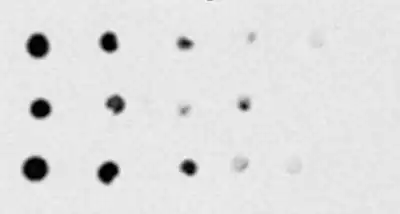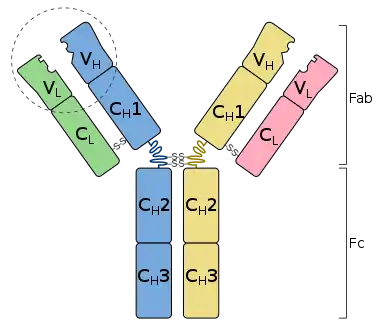Dot blot

A dot blot (or slot blot) is a technique in molecular biology used to detect proteins. It represents a simplification of the western blot method, with the exception that the proteins to be detected are not first separated by electrophoresis. Instead, the sample is applied directly on a membrane in a single spot, and the blotting procedure is performed.[1][2][3]
The technique offers significant savings in time, as chromatography or gel electrophoresis, and the complex blotting procedures for the gel are not required. However, it offers no information on the size of the target protein.[4]
Uses
The uses of the Dot (Slot) blot are the following:
- Performing a dot blot is similar in idea to performing a western blot, with the advantage of faster result and lower cost.[5][6]
Methods
A general dot blot protocol involves spotting 1–2 microliters of a samples onto a nitrocellulose or PVDF membrane and letting it air dry. Samples can be in the form of tissue culture supernatants, blood serum, cell extracts, or other preparations.[8]
The membrane is incubated in blocking buffer to prevent non-specific binding. It is then incubated with a primary antibody followed by a detection antibody or a primary antibody conjugated to a detection molecule. After antibody binding, the membrane is incubated with a chemiluminescent substrate and imaged.[9][10]
 An antibody: two heavy chains , two light chains
An antibody: two heavy chains , two light chains PVDF
PVDF
Apparatus
Dot blot is conventionally performed on a piece of nitrocellulose membrane or PVDF membrane. After the protein samples are spotted onto the membrane, the membrane is placed in a plastic container and sequentially incubated in blocking buffer, antibody solutions, or rinsing buffer on shaker. Finally, for chemiluminescence imaging, the piece of membrane need to be wrapped in a transparent plastic film filled with enzyme substrate.[11][12][13]
Vacuum-assisted dot blot apparatus has been used to facilitate the rinsing and incubating process by using vacuum to extract the solution from underneath the membrane, which is assembled in between several layers of plates to ensure good seal between sample wells, hold waste solution, and deliver suction force. For chemiluminescence signal detection, apparatus need to be disassembled and the membrane need to be taken out and wrapped in a transparent plastic film.[11][12][13][14]
See also
- Gel electrophoresis of nucleic acids
- Restriction fragment
- Genetic fingerprint
- Northern blot
- Western blot
- Eastern blot
- Southwestern blot
- Northwestern blot
- Far-eastern blot
References
- ↑ Stott, D. I. (12 May 1989). "Immunoblotting and dot blotting". Journal of Immunological Methods. 119 (2): 153–187. doi:10.1016/0022-1759(89)90394-3. ISSN 0022-1759. Archived from the original on 9 February 2022. Retrieved 9 February 2022.
- ↑ Yu, S M; Gorovsky, M A (10 October 1986). "In situ dot blots: quantitation of mRNA in intact cells". Nucleic Acids Research. 14 (19): 7597–7615. ISSN 0305-1048. Archived from the original on 9 February 2022. Retrieved 9 February 2022.
- ↑ Kirby, Lorne T. (23 September 1993). DNA Fingerprinting: An Introduction. Oxford University Press. p. 104. ISBN 978-0-19-804437-6. Archived from the original on 9 February 2022. Retrieved 9 February 2022.
- ↑ "Test Blots, Slot Blots & Dot Blots - Immunodetection | Bio-Rad". Bio-Rad. Archived from the original on 2021-06-03. Retrieved 2021-12-17.
- ↑ Kessler, Christoph (6 December 2012). Nonradioactive Analysis of Biomolecules. Springer Science & Business Media. p. 423. ISBN 978-3-642-57206-7. Archived from the original on 10 February 2022. Retrieved 10 February 2022.
- ↑ Mahon, Connie R.; Lehman, Donald C.; Manuselis, George (25 March 2014). Textbook of Diagnostic Microbiology - E-Book. Elsevier Health Sciences. p. 219. ISBN 978-0-323-29262-7. Archived from the original on 16 February 2022. Retrieved 16 February 2022.
- ↑ Rupprecht, Kevin R.; Nair, Rad K.; Harwick, Larissa C.; Grote, Jonathan; Beligere, Gangamani S.; Rege, Sushil D.; Chen, Yon-Yih; Lin, Zhen; Fishpaugh, Jeffrey R. (15 December 2010). "Development of a dot-blot assay for screening monoclonal antibodies to low-molecular-mass drugs". Analytical Biochemistry: 160–164. doi:10.1016/j.ab.2010.08.003. PMID 20696124.
- ↑ "Dot Blot Protocol" (PDF). Archived (PDF) from the original on 2021-06-03. Retrieved 2021-12-17.
- ↑ "Dot blot protocol". www.usbio.net. Archived from the original on 12 February 2022. Retrieved 12 February 2022.
- ↑ "Dot Blot Analysis". imagej.nih.gov. Archived from the original on 20 January 2022. Retrieved 13 February 2022.
- 1 2 Farrell, Robert E. (1 January 2005). "CHAPTER 9 - Dot Blot Analysis". RNA Methodologies (Third Edition). Academic Press. pp. 179–189. ISBN 978-0-12-249696-7. Archived from the original on 13 January 2022. Retrieved 10 February 2022.
- 1 2 Wehr, Nancy B.; Levine, Rodney L. (15 April 2012). "Quantitation of Protein Carbonylation by Dot Blot". Analytical Biochemistry. 423 (2): 241–245. doi:10.1016/j.ab.2012.01.031. ISSN 0003-2697. Archived from the original on 11 February 2022. Retrieved 11 February 2022.
- 1 2 Stanta, Giorgio (6 June 2011). Guidelines for Molecular Analysis in Archive Tissues. Springer Science & Business Media. pp. 115–116. ISBN 978-3-642-17890-0. Archived from the original on 15 February 2022. Retrieved 15 February 2022.
- ↑ Parkes, Helen; Saunders, V. (Ginny) (31 October 2007). Analytical Molecular Biology: Quality and Validation (143 ed.). Royal Society of Chemistry. ISBN 978-1-84755-929-6. Archived from the original on 23 February 2022. Retrieved 22 February 2022.